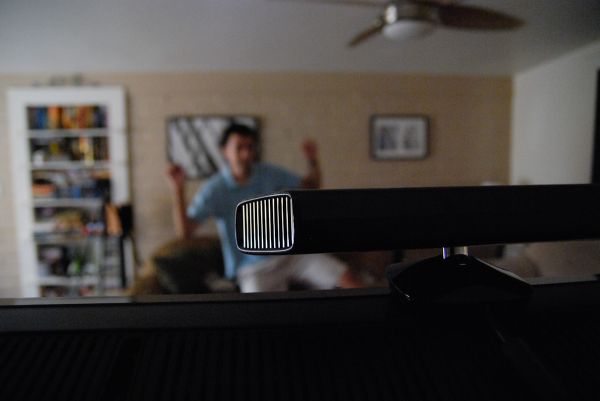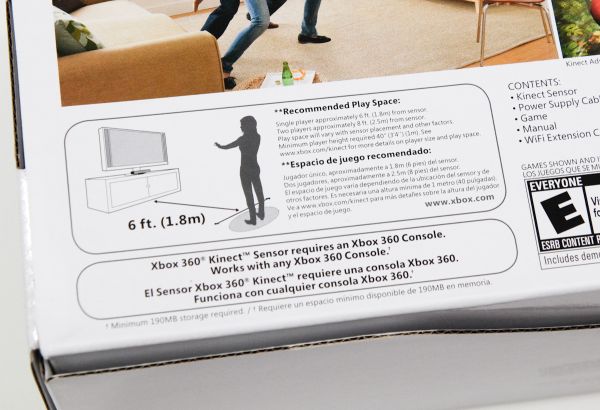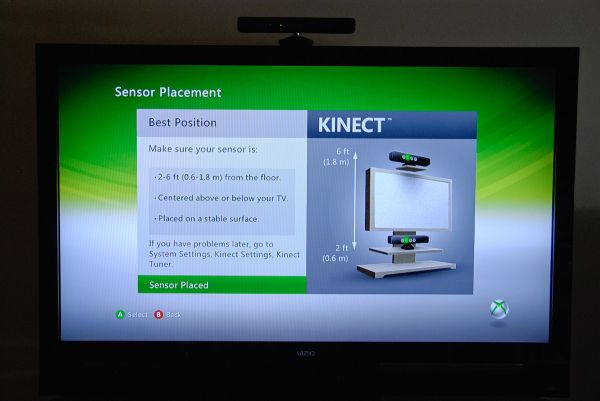Microsoft Kinect: The AnandTech Review
by Brian Klug on December 9, 2010 3:20 PM ESTKinect - Environmental Constraints
There are a lot of environmental constrains that the Kinect imposes, but the system actually works extremely well. Inside the manual and throughout the literature distributed with Kinect are notices about reducing ambient sunlight in the room you’re using the Kinect. At the same time, you need ambient light for the RGB color camera to work - this seems somewhat confusing until you consider that sunlight also contains spectral components at the same wavelength the Kinect operates at. Lots of ambient sunlight thus decreases the visibility of those spots on the room and players, and could conceivably make depth detection much worse. That sort of reminds me how the Wii sensor bar could be emulated with candles some distance apart atop the television, or how playing with the Wii next to a fireplace could easily make the system glitch out.
In practice, I never once noticed problems with depth detection on Kinect that I’d blame on ambient noise from stray light sources - even in a room with, yes, a huge fireplace (hey, it’s a reasonable test). The more important consideration actually turns out to be the relatively poor sensitivity of the RGB camera, which requires lots of room lighting to get decent framerate or augment facial detection.
The more important consideration for playing space is play space size - you need a big room to use Kinect. On the back of the Kinect packaging, Microsoft notes that a distance of 6’ from TV to players is requisite at minimum. After a lot of testing, I’d say 6’ is optimistic, even for one person. In actuality I’d say 9’-12’ is closer to what is optimal, especially if you want to play with a second person, and later inside games you’ll be told as much.
Sensor position itself makes a lot of difference here - Kinect can go either on top or below the TV, and Microsoft recommends anywhere 2’ - 6’ off the ground. Ultimately, the bar is that Kinect needs to be able to see your entire person - feet, head, and some distance around you to move, jump, and flail your arms around inside. If you place the Kinect on an entertainment center table below the TV, the hazard is that the depth of the table will block part of the depth image at the bottom. I had much more success with placing the Kinect atop TVs, especially when you encounter LCDs and pasmas of the wall-mounted sort.
The first area I tested was my living room, which is reasonably large (or so I used to think), and I played with about 7 feet away from the sensor. I moved a coffee table, unfortunately moving my couch is prohibitively difficult, and I didn’t have space to get rid of it. I was able to play with two people, but it was a bit cramped, and I felt like I needed more distance from the TV the whole time.
 See that above me? Yeah, it's a ceiling fan.
See that above me? Yeah, it's a ceiling fan.
The consideration I didn’t think of is what’s above. Needless to say, you need space to flail your arms around, especially if you’re tall. Above me within arm’s reach is a ceiling fan. That’s a serious problem if you get excited and jump with your arms above your head, as my girlfriend experienced a few minutes into our first session of Kinect Adventures. Ultimately, I can’t blame Kinect for my living room being small, but you need to be aware of the space constraints - Kinect won’t work in dorm rooms or tiny play areas, but does work with at least average sized living rooms. It’s entirely constrained by the field of view of the sensor and CGH, and admittedly it’s hard to make very wide angle CGH systems with good uniformity and repeatability.
I later tried Kinect in a much larger space with more than 12’ of space behind a wall-mounted plasma, with the Kinect mounted atop the display about 6.5’ above the ground. I had much more success here both with detection of my feet, and two-player space.
If you’re running out of space or are playing with just barely enough, the problems that arise are what you’d expect. Kinect won’t see your feet very well, or miss your hands, but thankfully most of the time you’re given feedback visually on the display that you need to move back into the optimal position.
The interesting bit of the Kinect space story is that closer to the sensor, you get better depth resolution at the cost of having less space to work in, yet far away you sacrifice depth resolution for more working area. It’s a simple consequence of field of view and the angular separation of those points in the CGH image. Prime Sense advertises that their reference design has a depth resolution of 1 cm at two meters from the sensor. As you move further away, that depth resolution gets worse (larger).
The final note is that I’ve actually noticed that clothing choice makes a difference. In fact, there are a few warnings in the literature shipped with games which notes that some clothing choices may make detection hard. I never had serious issues being detected outside of one special combination of cargo shorts and a specific footwork-heavy move in Dance Central, but more on that later. Common sense applies here, and essentially you need to look human and have some depth contrast visible for Kinect to detect your limbs.













72 Comments
View All Comments
Noriaki - Thursday, December 9, 2010 - link
Yeah, I just meant the 350 part. Referring to it as the 360 S to distinguish it from the 360 Pro makes sense to me.Noriaki - Thursday, December 9, 2010 - link
PS: Thanks for the in-depth coverage. This is the first time I feel like I got a good idea of what having a Kinect in my living room would mean for practical things like where my couch lives.Aikouka - Thursday, December 9, 2010 - link
Brian, have you tried out DanceMasters (DM)? I noticed you commented on how your girlfriend compared Dance Central (DC) to DDR where DanceMasters is actually created by Konami.I own DM and have played the DC game, and I have to say... you'd probably be disappointed in the DM menu system as it is a tad bit harder to control. Way too often I found myself skipping past the option I wanted (as all options move left or right) and you then have to raise your (right) hand to select it. The problem comes when it might see you move your hand out to the right and actually shift your choice over one right before you raise your hand.
The part where I think DM beats DC is the actual dancing. In the demo for DC, I found it awkwardly difficult to pay attention to the way the dancer was moving (left or right, etc) and the upcoming movement that was shown on the right side of the screen. When my brother and his girlfriend played, I noticed one huge trend... we *all* would miss the first dance move after they changed from one move to another.
This is kind of better in DM, because it uses arrows that signify how your hand (or hands) should move in a second or two. There are also circles that will appear on the screen and you must hit them with either your hands or feet (obvious depending on the location). The last movement is the "pose silhouettes" that appear on the left and right side and are green in color. They move to the center of the screen and when the two silhouettes combine, you are supposed to be in that pose. The only problem is that it's not terribly picky on what you do in between these three types of inputs and another problem is that it loves to put circles beneath your feet (so you keep moving), but they're hard to notice. I found this easy to combat by simply always moving your feet.
Overall, there's a huge difference in the style of music between the two as well, which influenced my decision. I've never been a "Top 40s" kinda guy and I've played DDR quite a bit, so I went with the game that had the music style I was used to ( and also considering that I've heard quite a bit of Eurobeat, which DM also has ).
The one thing that was always fun about DC was the "freestyle" section where it shows you as this sort of glowing silhouette and you just do whatever dance you want. At the end, it will play this back to you in a sort of time-lapse video (which you can then save).
To talk about a different game, I noticed some problem with jumping in Kinect... mostly in the rail-based obstacle course. Maybe I was just doing little hops and Kinect didn't register it... maybe it was a problem with the cargo pants (khaki color, so they're fairly flesh-toned) that I was wearing. It was pretty crazy though... at one point I had to duck down, so I dropped to my knees and then needed to switch sides, so I pulled out the Starfox-esque barrel roll! Kinect did actually sense that correctly.
The one thing I did notice is that it is *very* common in Kinect Adventures for it to yell at me about getting too close or too far... especially in the bubble popping mini-game.
Brian Klug - Thursday, December 9, 2010 - link
I haven't checked out Dance Masters, but I'm starting to think that I definitely should. I think at the time when I originally put together this list of games, that wasn't available and I overlooked it. I'll grab it and maybe update with a page or two.It's interesting how dancing games are quickly becoming something Kinect is very well suited for. I definitely agree about jumping and the clothing choice, I have a pair of cargo shorts that just don't work with most of the titles, and Kinect Adventures does yell a lot about position, agreed.
-Brian
GSJ - Thursday, December 9, 2010 - link
If only i could use this with my p.c.....ExarKun333 - Thursday, December 9, 2010 - link
I purchased the Kinect soon after the launch and I came to pretty much the same conclusions are Brian. The lag is there, but acceptable. More importantly, the games are FUN. MS did a great job with this launch. The hardware is easy to install and configure, and the games are easy to pick up on. I agreed 100% that the menus in DC are superior to the method in the Dashboard. Maybe an update at some time? :)knowom - Thursday, December 9, 2010 - link
267ms on a DAW would be completely unthinkable in fact most people that play or record music try to stay below 10ms.I'm just using that example as a clear easy to demonstrate reason to why 267ms is a abysmal amount of input lag you can completely rule out music based kinect games as well as any twitch/quick reflex input games or applications.
SodaAnt - Thursday, December 9, 2010 - link
In the comment about the laser probably being 650-700 nm, that is wrong. 650nm is the wavelength of a normal red laser pointer. Normal IR diodes lase at either 780, 808 or 980nm.Brian Klug - Thursday, December 9, 2010 - link
Hmm it's on the fringes of what I'd consider visible, but 780 probably is a much better choice. I'll update.-Brian
mcnabney - Thursday, December 9, 2010 - link
Okay, I am probably the only prig to bring this up, but the distances required seem to be a problem for some not often thought of reasons.9-12 feet of clearance appears to be required, which means the sofa will need to be 15' back (unless you move it every time you fire up the Kinnect).
I would point out that you would need to have a 55"+ HDTV to fully benefit from the 1080p image from the Kinnect playing area, For regular game playing / movie watching on the sofa (behind the playing area) you would require a 100"!!!!! screen to fully resolve the 1080p image that the Xbox360 or a BluRay player is capable of displaying.
For this thing to really work in a robust media environment (and most living rooms) it should have been able to to work perfectly with the user standing 3-5' from the screen.